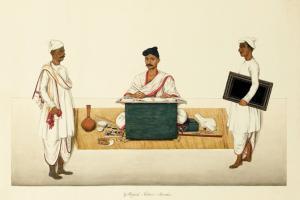William Darlymple's latest book celebrates faceless Indian artists commissioned by the East India Company who developed a unique style that was two-third Mughal, one-third European, but ignored by both India and England

Yellapah Picture Moochee, self-portrait of Yellapa. Pics courtesy/ Forgotten Masters
A painting in the Vellore Album, housed at Sotheby's New York, shows Indian artist Yellapah of Vellore seated cross-legged in front of a drawing table with the paraphernalia of his trade strewn around him. Flanked by two assistants, Yellapa's gaze is firmly on the viewer. The inscription below reads, Yellapah Picture Moochee. The arresting self-portrait dates back to 1825. But, until recently, Yellapah was unknown in India.
Scores of Indian artists like him, who created extraordinary paintings under the patronage of the East India Company, and its officials, have gone largely unnoticed. William Darlymple's latest book, Forgotten Masters: Indian Painting For The East India Company, seeks to correct the wrongs by drawing focus on this neglected phase of Indian art history. "It all began in 2013 when I was curating a show on Mughal art in New York, which had a few frames from the current collection," says the Delhi-based author and historian. He found it problematic that most of these paintings, indistinguishable from Mughal paintings, were unceremoniously categorised as "Company school paintings".
"It did not make sense. We became irritated with the way they emphasised the colonial patronage of these works over the brilliance of the Indian artists who painted them. When I was invited to do a show by the Wallace Collection last year, I chose to do it on these paintings," he shares. Dalrymple consciously avoided using the term "Company paintings" and has instead, portrayed the works as from a neglected phase of late Mughal India.

Hanging fruit bat by Bhawani Das
Curiously, little is known about these works in both England and India. According to him, museums in the UK have shied away from displaying the artworks due to what he calls post-colonial angst, and the fact that they were associated with British imperialism. "They were embarrassed by colonial content and saw it as something dodgy and toxic," he says. The story is no different here. "The works haven't been seen as entirely Indian in India either. For example, eminent scholar PN Goswami's three-volumes study on Masters Of India Painting, gives only a cursory glimpse of these artists. All these painters are dismissed in a single swoop." Dalrymple's book covers the works of 100 little-known artists, such as Shaikh Zain ud-Din, Bhawani Das, Ram Das, Shaikh Muhammad Amir of Karraya, Yellapah of Vellore and Ghulam Ali Khan. From commissioning to opening the exhibition, the project took 18 months. "We moved at breakneck speed. An exhibit of this size would usually take five years," he jokes. The selection was based entirely on his aesthetic judgment.

Sarus crane by Shaikh Zain ud-dun
The artists who produced these works hailed from modest backgrounds and were discovered from a wide variety of Indian artistic traditions—Mughal, Maratha, Punjabi, Pahari, Tamil and Telugu. Most works were commissioned for scientific purposes or as personal mementos. "The first pictures were commissioned by Claude Martin in the late 1770s at a time when botany and zoology were the twin passions among intellectual Europeans. Claude Martin imported no fewer than 17,000 sheets of European watercolour paper and employed a team of Lucknavi master artists to paint a series of natural history pictures," he says. Between 1777 and 1783, painter Shaikh Zain ud-Din, assisted by Bhawani Das and Ram Das, contributed to the 326 natural studies commissioned by English natural historian and patron of arts in Bengal, Mary Impey and her husband Elijah Impey, the Chief Justice of Bengal. The choice of subjects ranged from plants and animals, to street scenes and architectural studies. The artists were mainly trained in the Mughal style, chintz and the Kalamkari textile technique of Andhra Pradesh, but were shown European natural history images and lithographs as samples. The amalgam gave birth to a new hybrid style, one that was unique in representation. "It is two-third Mughal and one-third European. These were scientific specimens against white background."

Interestingly, some of the paintings poke fun at the powers that be with wry humour. "For instance, Shaikh Mohammad Amir of Karriah has this extraordinary painting of a colonial girl with her face absent. The servants have been given character but the girl is made to look like she's not entirely human. There's another painting by Yellapah, where he makes the sahib look visibly uncomfortable on the palanquin."
Dalrymple says the detailing if seen up close, is jaw-dropping.
The response from the British critics to the show's opening in London was more than encouraging, says Dalrymple. "The Guardian's art critic Jonathan Jones, who is very hard to please and loves giving shows only one star, gave us five. People are wondering why they haven't seen this before."
Catch up on all the latest Mumbai news, crime news, current affairs, and also a complete guide on Mumbai from food to things to do and events across the city here. Also download the new mid-day Android and iOS apps to get latest updates
 Subscribe today by clicking the link and stay updated with the latest news!" Click here!
Subscribe today by clicking the link and stay updated with the latest news!" Click here!









